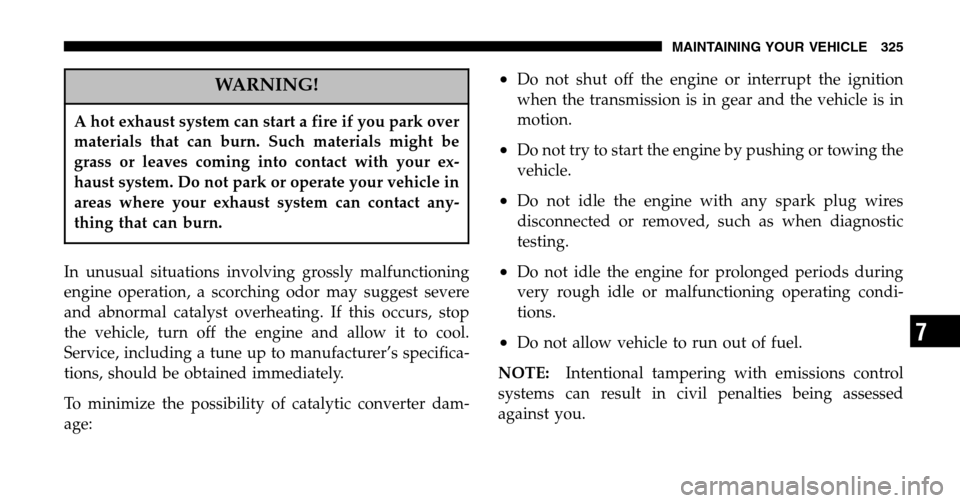Page 307 of 424

JUMP STARTING — GASOLINE ENGINES
NOTE:Check the charge indicator on the battery. If the
indicator is light or yellow, replace the battery.
1. Wear eye protection and remove any metal jewelry
such as watch bands or bracelets that might make an
unintended electrical contact.
2. When boost is provided by a battery in another
vehicle, park that vehicle within booster cable reach but
without letting the vehicles touch. Set the parking brake,
place the automatic transmission in P (Park), or manual
transmission in N (Neutral), and turn the ignition to OFF
for both vehicles.
3. Turn off the heater, radio and all unnecessary electrical
loads. 4. Connect one end of a jumper cable to the positive
terminal of the discharged battery. Connect the other end
of the same cable to the positive terminal of the booster
battery.
5. Connect the other cable, first to the negative terminal
of the booster battery and then connect the other end to
a non-paint metal surface on the engine of the vehicle
with the discharged battery. Make sure you have a good
contact on the engine.
6. Start the engine in the vehicle which has the booster
battery, let the engine idle a few minutes, then start the
engine in the vehicle with the discharged battery.
7. When removing the jumper cables, reverse the above
sequence exactly. Be careful of the moving belts and fan.
WHAT TO DO IN EMERGENCIES 307
6
Page 317 of 424

the fuel filler cap properly to turn the message off (light
will time out). If the problem continues, the message will
appear the next time the vehicle is started.
EMISSIONS INSPECTION AND MAINTENANCE
PROGRAMS
In some localities, it may be a legal requirement to pass
an inspection of your vehicle’s emissions control system.
Failure to pass could prevent vehicle registration. For states which have an I/M (Inspection and
Maintenance) requirement, this check verifies the
following: the MIL (Malfunction Indicator Lamp)
is functioning and is not on when the engine is running,
and that the OBD (On Board Diagnostic) system is ready
for testing.
Normally, the OBD system will be ready. The OBD
system may notbe ready if your vehicle was recently
serviced, if you recently had a dead battery, or a battery replacement. If the OBD system should be determined
not ready for the I/M test, your vehicle may fail the test.
Your vehicle has a simple ignition key actuated test
which you can use prior to going to the test station. To
check if your vehicle’s OBD system is ready, you must do
the following:
1. Insert your ignition key into the ignition switch.
2. Turn the ignition to the ON position, but do not crank
or start the engine.
3. If you crank or start the engine, you will have to start
this test over.
4. As soon as you turn your key to the ON position, you
will see your MIL symbol come on as part of a normal
bulb check.
5. Approximately 15 seconds later, one of two things will
happen:
MAINTAINING YOUR VEHICLE 317
7
Page 318 of 424

a. The MIL will flash for about 10 seconds and then
return to being fully illuminated until you turn off the
ignition key or start the engine. This means that your
vehicle’s OBD system is not readyand you should not
proceed to the I/M station.
b. The MIL will not flash at all and will remain fully
illuminated until you turn off the ignition key or start
the engine. This means that your vehicle’s OBD system
is ready and you can proceed to the I/M station.
If your OBD system is not ready,you should see your
authorized dealer or repair facility. If your vehicle was
recently serviced or had a battery failure or replacement,
you may need to do nothing more than drive your
vehicle as you normally would in order for your OBD
system to update. A recheck with the above test routine
may then indicate that the system is now ready.
Regardless of whether your vehicle’s OBD system is
ready or not ready, if the MIL symbol is illuminated during normal vehicle operation, you should have your
vehicle serviced before going to the I/M station. The I/M
station can fail your vehicle because the MIL symbol is on
with the engine running.
REPLACEMENT PARTS
Use of genuine Mopar
�parts for normal/scheduled
maintenance and repairs is highly recommended to in-
sure the designed performance. Damage or failures
caused by the use of non-Mopar �parts for maintenance
and repairs will not be covered by the manufacturer’s
warranty.
DEALER SERVICE
Your dealer has the qualified service personnel, special
tools and equipment to perform all service operations in
an expert manner. Service Manuals are available which
include detailed service information for your vehicle.
Refer to these manuals before attempting any procedure
yourself.
318 MAINTAINING YOUR VEHICLE
Page 325 of 424

WARNING!
A hot exhaust system can start a fire if you park over
materials that can burn. Such materials might be
grass or leaves coming into contact with your ex-
haust system. Do not park or operate your vehicle in
areas where your exhaust system can contact any-
thing that can burn.
In unusual situations involving grossly malfunctioning
engine operation, a scorching odor may suggest severe
and abnormal catalyst overheating. If this occurs, stop
the vehicle, turn off the engine and allow it to cool.
Service, including a tune up to manufacturer’s specifica-
tions, should be obtained immediately.
To minimize the possibility of catalytic converter dam-
age:
•Do not shut off the engine or interrupt the ignition
when the transmission is in gear and the vehicle is in
motion.
•Do not try to start the engine by pushing or towing the
vehicle.
•Do not idle the engine with any spark plug wires
disconnected or removed, such as when diagnostic
testing.
•Do not idle the engine for prolonged periods during
very rough idle or malfunctioning operating condi-
tions.
•Do not allow vehicle to run out of fuel.
NOTE: Intentional tampering with emissions control
systems can result in civil penalties being assessed
against you.
MAINTAINING YOUR VEHICLE 325
7
Page 352 of 424
Power Distribution Center (Gasoline Engines)
Cavity Fuse Description
F1 40 Amp Green Blower Motor
F2 40 Amp Green Radiator Fan
F3 50 Amp Red JB Power
F4 40 Amp Green ABS Pump
F5 20 Amp Yellow NGC Trans
F6 30 Amp Pink ASD
F7 50 Amp Red JB Power
F8 40 Amp Green Ign/Start
F9 50 Amp Red JB Power
F10 30 Amp Pink Trailer Tow
F11 Open
F12 30 Amp Pink Light Bar
F13 40 Amp Green Windows
F14 40 Amp Green Ignition Switch
F15 50 Amp Red JB Power
Power Distribution Center
352 MAINTAINING YOUR VEHICLE
Page 354 of 424
Power Distribution Center (Diesel Engines)
Cavity Fuse Description
F1 40 Amp Green Blower Motor
F2 40 Amp Green Radiator Fan
F3 50 Amp Red JB Power
F4 40 Amp Green ABS Pump
F5 Open
F6 30 Amp Pink ASD
F7 50 Amp Red JB Power
F8 40 Amp Green Ign/Start
F9 50 Amp Red JB Power
F10 30 Amp Pink Trailer Tow
F11 20 Amp Yellow Fuel Heater
F12 30 Amp Pink Light Bar
F13 40 Amp Green Windows
F14 40 Amp Green Ignition Switch
F15 50 Amp Red JB Power
Cavity Fuse Description
F16 15 Amp Blue ASD Feed
F17 Open
F18 Open
F19 30 Amp Pink Rear Window Defogger (HBL)
F20 Open
F21 20 Amp Yellow A/C Clutch
F22 Open
F23 Open
F24 Open
F25 20 Amp Yellow ABS Valves
F26 25 Amp Natural Injectors
F27 Open
F28 15 Amp Blue Starter
R29 Half ISO Relay Fuel Heater
R30 Half ISO Relay Starter
354 MAINTAINING YOUR VEHICLE
Page 355 of 424

Cavity Fuse Description
R31 Half ISO Relay Wiper On/Off
R32 Half ISO Relay Wiper Hi/Lo
R33 Full ISO Relay H. Blower
R34 Full ISO Relay Rad. Fan Hi
R35 Half ISO Relay A/C Clutch
R36 Half ISO Relay Viscous Heat
R37 Open
R38 Open
R39 Full ISO Relay ASD
R40 Full ISO Relay Rad. Fan LoVEHICLE STORAGE
If you are leaving your vehicle dormant for more than 21
days you may want to take steps to protect your battery.
You may:
•Remove Cartridge fuse #15 in the Power Distribution
Center labeled Ignition-Off Draw (IOD).
•Store the removed IOD fuse in the Power Distribution
Center location #11 labeled “IOD Storage.”
•Or, disconnect the negative cable from the battery.
•Anytime you store your vehicle, or keep it out of
service (i.e. vacation) for two weeks or more, run the
air conditioning system at idle for about five minutes
in the fresh air and high blower setting. This will
insure adequate system lubrication to minimize the
possibility of compressor damage when the system is
started again.
MAINTAINING YOUR VEHICLE 355
7
Page 404 of 424

Caution, Exhaust Gas................... 72,147
CD (Compact Disc) Changer .............189,199
CD (Compact Disc) Player .........185,187,191,194
CD (Compact Disc) Player Maintenance ........ 207
Cellular Phone ........................ 83,207
Center High Mounted Stop Light ............ 361
Chains, Tire ............................ 274
Changing A Flat Tire ..................... 302
Charging System Light .................... 175
Chart, Tire Sizing ........................ 254
Check Engine Light (Malfunction Indicator Light) . 317
Child Restraint ...................... 61,66,69
Child Restraint Tether Anchors .............65,66
Child Safety Locks ........................ 21
Climate Control ......................... 208
Clock ................................ 183
Clutch Interlocking Ignition System ........217,226
Command-Trac Operation .................. 234
Compact Disc (CD) Maintenance ............. 207 Compass
.............................. 143
Compass Calibration ..................... 143
Compass Variance ....................... 144
Computer, Trip/Travel .................... 141
Console, Overhead ....................... 135
Contract, Service ........................ 396
Converter, Catalytic ...................... 324
Cool Down, Turbo ....................... 220
Cooling System ......................... 332
Adding Coolant (Antifreeze) .............. 334
Coolant Capacity ...................... 362
Coolant Level ......................... 335
Disposal of Used Coolant ................ 335
Drain, Flush, and Refill .................. 332
Inspection ........................... 332
Points to Remember .................... 336
Pressure Cap ......................... 334
Radiator Cap ......................... 334
Selection of Coolant (Antifreeze) .........333,362
404 INDEX